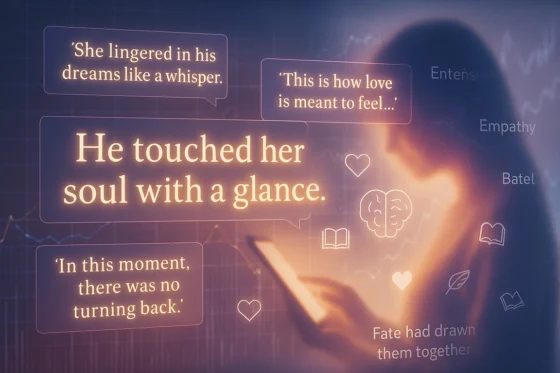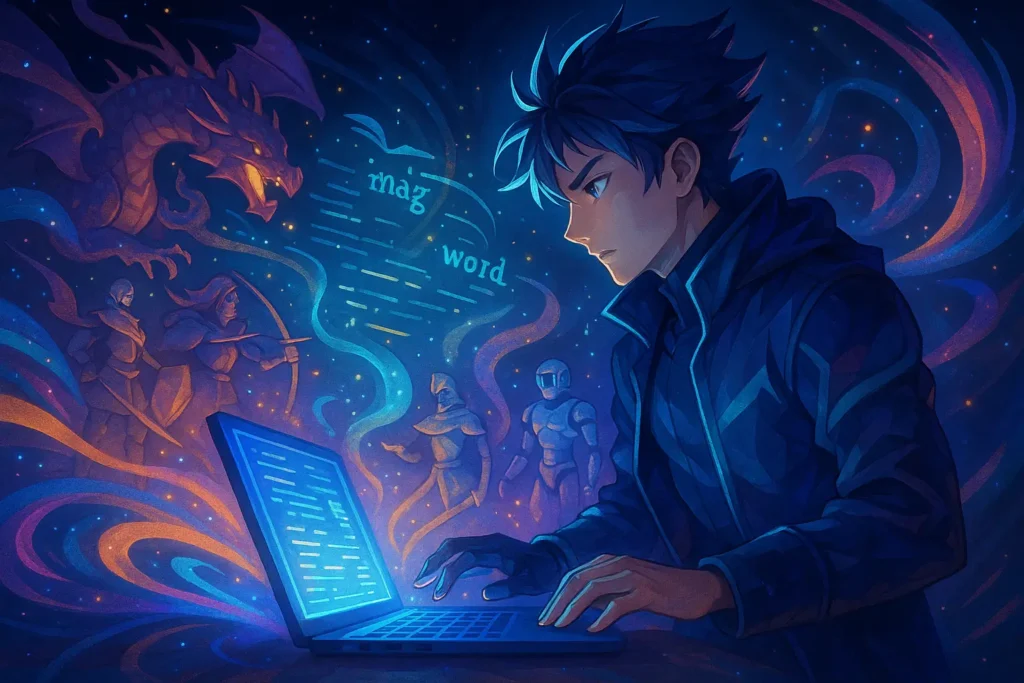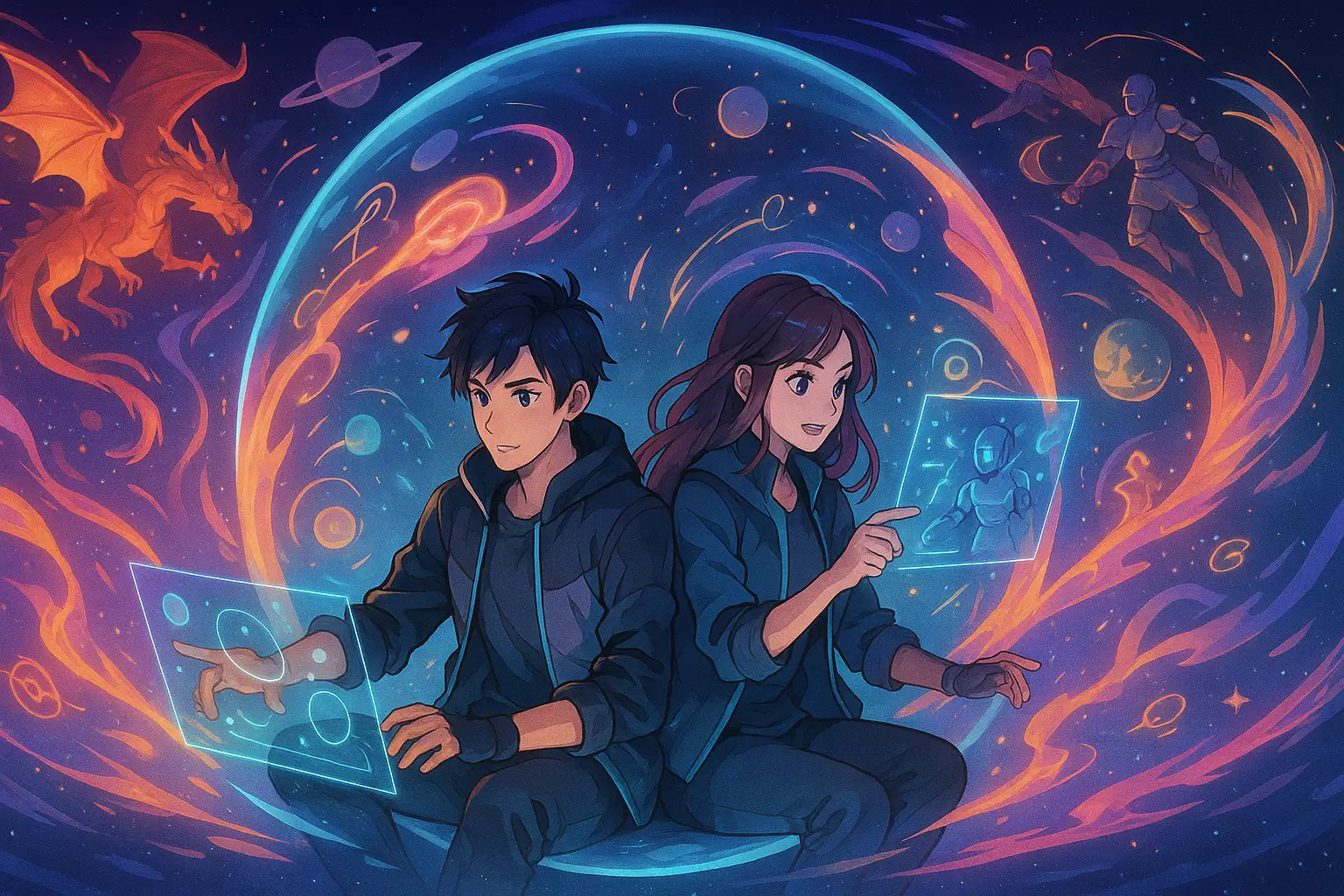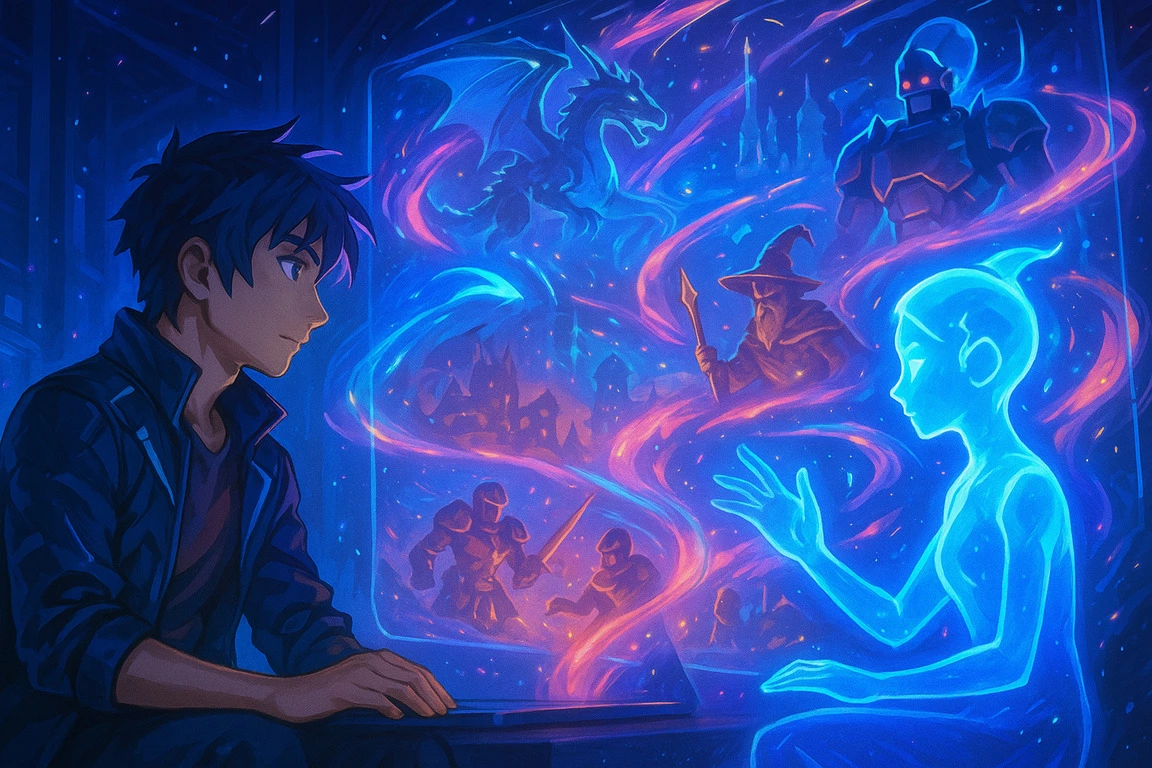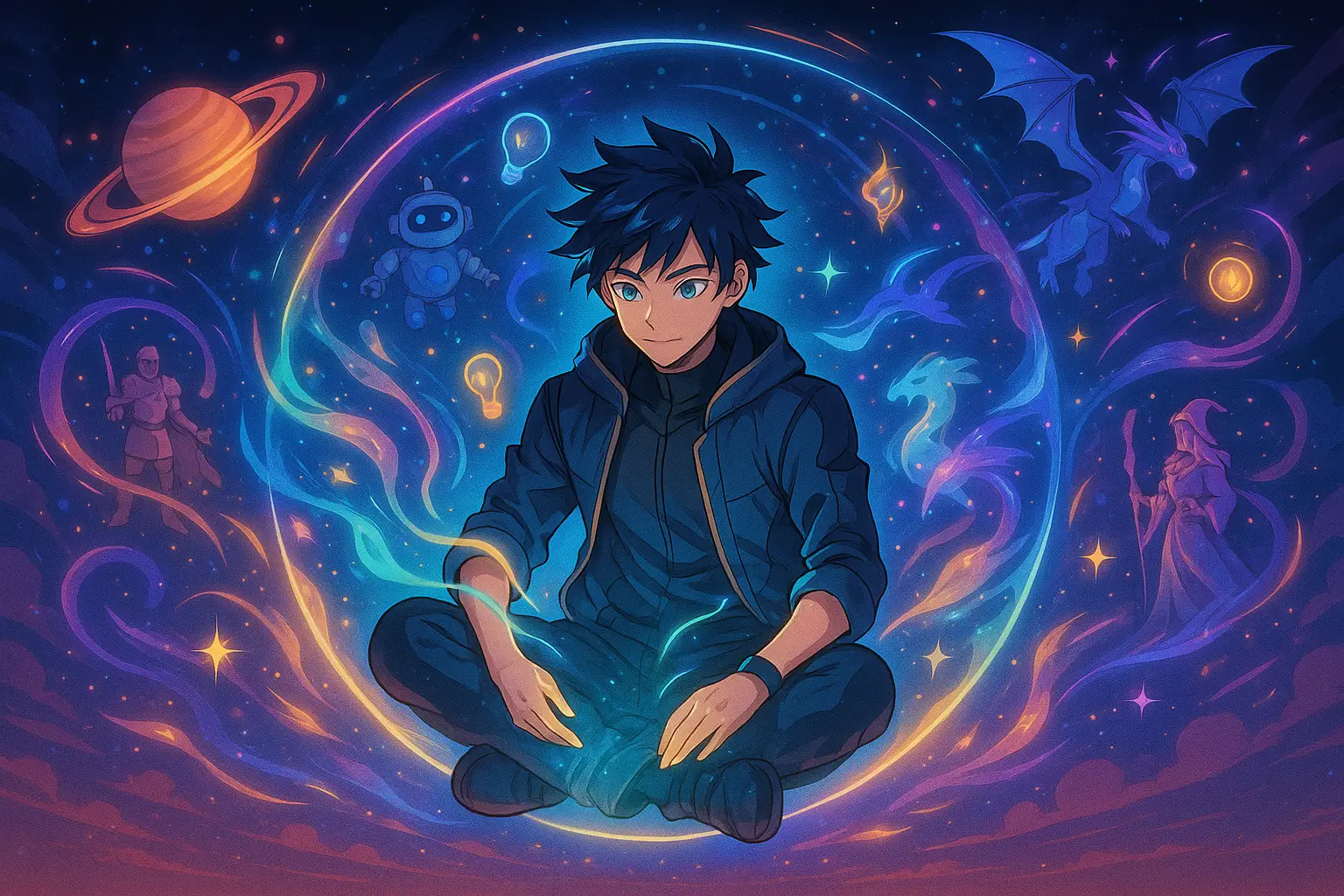Storytelling is as old as mankind. From the oral traditions told around campfires to the handwritten scrolls, printing presses, radio dramas, television, and digital media, each technological advance has changed how stories are told and shared. The development of the printing press in the 15th century democratized access to fiction. Jump into the 20th century, and television brought tales to every household. The proliferation of social media in the 2000s meant that anyone could be a storyteller. Today, we are entering a new age: AI storytelling. The digital content we watch (on Netflix, YouTube, TikTok) is already pre-determined by algorithmic recommendations. Artificial Intelligence is not just curating stories anymore. It’s creating them.
The Shift from Static to Dynamic Narratives
Traditionally, stories were linear: they were clear in their beginning, middle, and end. You viewed a movie, read a book, and played a level. The plot was set, and you were a passive consumer. However, digital platforms brought interactivity – think “choose your own adventure” books, or branching video game plots. That was the first break in the static storytelling model.
Now, AI storytelling tools such as TalkToStory are taking it further. These platforms allow co-authoring narratives in real time by users. You can enter a scene idea, make a choice, and get personalized continuations instantly.
According to a 2023 report by Deloitte, more than 40% of Gen Z consumers claim to be more entertained by interactive stories than traditional linear content. AI storytelling adapts on the fly—responding to user input, learning preferences, and even adjusting emotional tone. This dynamic model not only makes stories interesting but also personal.
Why AI Storytelling Is the Next Major Leap
AI storytelling marks a true paradigm shift: it not only redistributes or alters content, but also produces it. Powered by large language models (LLMs) trained on billions of words, Artificial Intelligence can generate original plots, dialogue, characters, and even world-building elements in seconds. For example, OpenAI’s GPT-4 model is capable of producing coherent multi-chapter narratives with stylistic continuity. Tools such as Sudowrite help human authors in brainstorming, rewriting, and even tone-matching. Educational apps leverage the power of Artificial Intelligence to create pieces that change by the moment to suit a child’s reading level and interests.
In other words, the old days of storytelling as a one-way street are over. Thanks to smart algorithms, it is now collaborative, flexible, and infinitely scalable. And with personalization being the norm rather than the exception, Artificial Intelligence is set to be the making of the next chapter in human creativity.
Love immersive experiences?
Join a growing TalkToStory Community and bring your characters, worlds, and stories to life alongside like-minded creators.
Technologies Behind AI Storytelling
What makes AI storytelling tick? Under the hood, there is a symphony of technologies that collaborate to provide personalized, engaging narratives in real time.
Natural Language Processing (NLP)
At the core of every AI-driven story is a Natural Language Processing technology that enables machines to comprehend, understand, and create human language. NLP enables AI storytelling apps to grasp sentence structure, context, tone, and even intent. It makes sure that when a user types, “Make the knight fall in love with the dragon”, the system doesn’t just reply grammatically, but also meaningfully. NLP advancements let such utilities as TalkToStory and ChatGPT develop human-like discussions, which seem emotionally compelling and logically consistent. It’s the brain of the story, the thing that keeps characters in character, plots plausible, and dialogue sharp.
Generative AI and Neural Networks
Generative AI, powered by advanced neural networks, serves as the creative engine behind modern AI storytelling. These models are trained with large databases of books, scripts, dialogues, and other text materials. Some of the prominent datasets include Common Crawl, BookCorpus, Wikipedia, and WebText that offer a wide variety of linguistic structures and narrative styles. Through such training, models such as GPT-4 and Claude learn to write material that is original but reflects human-like creativity and coherence.
Unlike the conventional methods that depend on pre-defined templates or rules, generative AI models use deep learning architectures, such as transformers, to understand context and create new narratives. That enables them to create stories in different genres, from medieval fantasy epics to futuristic cyberpunk thrillers, adapted to certain moods, themes, or the level of reading. For example, in the world of scriptwriting, this technology has enabled a reduction of production planning time to as low as 60% in terms of effectiveness of content creation.
Reinforcement Learning for Interactive AI Storytelling
Interactivity is a cornerstone of AI storytelling, distinguishing it from traditional linear narratives. Using reinforcement learning (RL), AI-powered systems are able to dynamically adjust to user choices and therefore are well-suited for branching stories in gaming and education. In gaming, RL allows apps to learn from what the players do, making adjustments to narratives in real-time to provide individualized experiences. For example, TalkToStory makes use of state-of-the-art natural language processing and machine learning to produce interactive fictions that adapt to player input, taking the old “choose-your-own-adventure” concept into the modern age.
Multimodal AI
Why stop at words? Multimodal AI utilizes text, images, sound, and video in making richly immersive experiences. Just imagine an app that writes your sci-fi scene and also illustrates it, voices the characters, and creates a soundtrack to accompany it. This tech will power the next-gen AI storytelling set to blur the line between literature and simulation. Platforms will allow users to be in AI-generated virtual worlds where narrative, visuals, and voice are all dynamically created, making passive readers become active participants.
Love immersive experiences?
Join a growing TalkToStory Community and bring your characters, worlds, and stories to life alongside like-minded creators.
Rethinking the Classics -Story Frameworks
For centuries, fiction has followed familiar patterns—think of Joseph Campbell’s Hero’s Journey or Freytag’s Pyramid. These linear structures have helped storytellers craft compelling arcs with a beginning, climax, and resolution. But ArtificiaI Intelligence? It’s rewriting the rules.
Forget the Hero’s Journey—Meet the Modular Storyline
Conventional fiction usually demands a predetermined path of the narrative. But Artificial Intelligence thrives on flexibility. Instead of one grand arc, modular AI storytelling breaks a tale into smaller, interchangeable chunks that can be reassembled based on user choices or data input. It’s LEGO for narratives – custom-built, re-arrangeable, and infinitely scalable. This approach is used by interactive tools such as StoryStream and Plot Generator to dynamically create stories for marketing, games or e-learning material. With modular design, your piece doesn’t act according to the script – it reacts and develops.
AI Doesn’t Just Write—It Adapts in Real Time
One of the defining strengths of AI storytelling is its ability to adapt instantly. If you change the genre in the middle of your narrative or bring in a new character on the fly, the system adjusts and moves along without a hiccup. This real-time adaptability makes this technology uniquely suited for applications in gaming, personalized education, and virtual reality experiences, where user input is constant, and the story must evolve accordingly.
Personalization Means You Become the Protagonist
AI storytelling tools don’t just write for you—they write about you. By leveraging user data, preferences, and prior interactions, they can shape stories that mirror your interests, emotional tone, or even moral alignment.
In educational tools like Talespin or therapeutic simulations, the protagonist’s experience is tailored to reflect the learner’s or patient’s journey, boosting engagement, empathy, and retention. It’s storytelling that sees you.
Nonlinear Narratives That Evolve with Your Choices? Yes, Please.
The days of opening to page 47 to check if you survived the cave are over. With the smart technology, nonlinear storytelling is easy and endless. Pick an option, the story changes – not just the next line, but the whole arc, characters, and world around.
Games, learning apps, and immersive storytelling platforms, like TalkToStory, use branching AI-driven narratives to create experiences that live. Every decision opens up new opportunities, and no two sessions are ever the same.
Love immersive experiences?
Join a growing TalkToStory Community and bring your characters, worlds, and stories to life alongside like-minded creators.
How AI Storytelling is Used Today
AI storytelling isn’t just a futuristic concept—it’s already transforming industries by making narratives more interactive, adaptive, and personalized. From watching Netflix to opening a marketing email to taking your kid through a learning game, there’s a high chance that Artificial Intelligence is the engine behind the story. Here’s how it happens.
Entertainment – Dynamic Worlds at Scale
In gaming and film, AI storytelling is a creative sidekick that never sleeps. Game studios such as Ubisoft have experimented with AI-generated narratives to make plotlines interactive, where the plots respond to player decisions, and no two journeys are identical.
Interactive fiction engines such as TalkToStory employ large language models to spin infinite worlds on the fly, allowing players to create every twist. Screenwriters also use AI-powered tools such as Sudowrite or ChatGPT to help them get out of writer’s block, brainstorm scenes, or create dialogue trees for immersive media. Artificial Intelligence speeds up the drafting process and creates new possibilities for creativity while keeping the artist behind the pen.
Marketing – Stories That Sell
That creepily appropriate product email or individualized ad campaign? It could have been written by the interactive storyteller. Such platforms as Persado apply NLP and predictive analytics for adjusting copy to your personality, past behavior, and emotional triggers. Marketers use Artificial Intelligence to test multiple narrative angles at once, adapting them in real-time to resonate with different audiences. The result: better-converting and more human-feeling content – even if it is machine-made.
Education – Teaching That Feels Like a Game
AI storytelling is redefining how we learn. Adaptive platforms such as Socratic or Quillionz develop interactive lesson narratives that adapt depending on a student’s answers, pace, and confidence level. Kids aren’t just taking in information—they’re living a personalized adventure that makes learning memorable. From history role-plays to science-based quests, this technology transforms dry lessons into heartfelt experiences that stay with the audience much better than a series of slides would.
Mental Health & Therapy – Empathy at Scale
Therapists and researchers use AI-generated narratives in cognitive behavioral therapy (CBT) and trauma recovery. Tools like Wysa and Koko create conversational scenarios that help users explore feelings, build resilience, or rehearse social situations.
Some platforms even generate emotionally tuned scripts that support mood regulation and mindfulness. While Artificial Intelligence can’t replace human empathy, it can offer supportive, low-stakes environments for reflection and healing.
Love immersive experiences?
Join a growing TalkToStory Community and bring your characters, worlds, and stories to life alongside like-minded creators.
Human + AI Collaboration in AI Storytelling
The rise of AI storytelling doesn’t diminish the role of the human writer—it enhances it. At its best, machines act not as a replacement, but as a creative augmentation layer. The human author remains in control of narrative vision, while technology provides structural support, ideation at scale, and continuity across branching plotlines.
Technology as Co-Writer Enhances Rather Than Replaces
Artificial Intelligence can generate dialogue, descriptive scenes, and even plot suggestions—but it lacks intuition, thematic consistency, and emotional subtlety. Human authors provide those critical elements. In practical terms, writers use this smart technology as a co-writer to:
- Rapidly draft scenes based on story prompts or character arcs.
- Suggest alternate narrative directions in nonlinear formats.
- Improve narrative flow and pacing through AI-assisted editing.
For example, platforms like TalkToStory allow real-time collaboration between humans and LLM, where the user drives the story and the system reacts dynamically, providing adaptive responses that evolve based on the user’s inputs. This is AI storytelling, not automation.
Real-Time Drafting, Editing, and World-Building
AI storytelling tools now provide robust functionality tailored to different phases of the creative workflow:
- Prompt-to-draft generation. Input a narrative seed (“a hacker in a dystopian city”) and receive several hundred words of coherent exposition or dialogue.
- Tone and structure refinement. Writers can specify adjustments like “make it more suspenseful” or “simplify for young readers,” and the AI-based tool makes real-time revisions.
Writers are increasingly using these capabilities to prototype scenes quickly, experiment with multiple versions of the same story, or enhance productivity when facing deadlines.
Maintaining Creative Integrity in AI-Augmented Workflows
One critical challenge is ensuring that AI-generated content aligns with the writer’s creative intent. To mitigate this, professional storytellers are developing hybrid workflows:
- Human-in-the-loop editing, where every AI-generated passage is reviewed, revised, or restructured to reflect narrative goals.
- AI-guided brainstorming, where large volumes of ideas are generated and then human-curated to ensure originality and cohesion.
- Interactive co-creation environments, where the system adapts to the user’s tone and direction in real time, maintaining narrative agency with the human user.
These models ensure that while Artificial Intelligence contributes to productivity and creative ideation, humans retain authorship and thematic control.
The Strategic Value – Faster Iteration, Greater Scalability
In such industries as entertainment, publishing, and marketing, the ability to quickly create high-quality narrative variants becomes a strategic advantage. Technology allows for experimentation with various storylines, personalizing content for different target audiences, and developing stories that involve the audience dynamically, which would be too laborious to do manually. However, storytelling is still a human art. AI is the assistant: powerful, fast, and multi-purpose—but the beating heart of all good stories is still written by a person who is aware of emotional resonance, cultural subtleties, and human nature.
Love immersive experiences?
Join a growing TalkToStory Community and bring your characters, worlds, and stories to life alongside like-minded creators.
Meet the Players – AI Storytelling Tools Compared
The AI storytelling landscape is booming, but not all tools are created equal. Some are idea enhancers for the authors, some create infinite fantasies, and a few (like TalkToStory) even take it a step forward and allow users to co-create stories in real time. Let’s break down how today’s top AI storytelling platforms compare, and what makes each one shine—or stumble—depending on your needs.
TalkToStory – AI Interactive Story-Telling in Real Time
Best For: Dynamic, branching narratives with audience input
Killer Feature: Real-time, choose-your-own-adventure collaboration
TalkToStory isn’t just an AI-based writing tool—it’s a full-on narrative playground. The platform is built for participatory storytelling, where users shape the plot as it unfolds. Unlike static text generators, TalkToStory is dynamic in providing flexible paths and modular story arcs that are adaptive to your choices.
It is like living a story, rather than reading one. Your choices affect the plot, character relationships, and secret story paths, so that each session is personal and unique. You can playback from different angles or test risky options, or find completely new results.
Fueled by adaptive AI, which recalls context and builds on prior events, TalkToStory ensures that each experience is natural and immersive. With themed collections – anime, romance, sci-fi, fantasy – you’re not after the “right” ending. You’re creating your ending.
Sudowrite – A Literary Sidekick for Authors
Best For: Novelists and fiction writers struggling for inspiration
Killer Feature: “Show, not tell” mode and character brainstorming
Sudowrite is meant to work in tandem with the conventional creative writing process. It’s cherished by authors for its potential to hint at metaphors, correct the pacing, and create sensory descriptions. But it’s a solo tool – it’s perfect for polishing prose, but not for branching or AI storytelling.
It is good at making you write better, not differently. For literary purists who want to keep their tone and voice under control, Sudowrite is like a kind editor who never gets tired.
AI Dungeon – Infinite Fantasy Adventure
Best For: Text-based role-playing fans and gamers
Killer Feature: Open-ended, GPT-powered story worlds
AI Dungeon is the chaotic-good wizard of the bunch. It makes sprawling fantasy stories in which Artificial Intelligence is the dungeon master who improvises scenes and replies based on your input. It is particularly popular in the fan fiction and RPG circles.
Although enjoyable and never-endingly surprising, AI Dungeon can be inconsistent with regard to long-term narrative sense, and it can sometimes produce bizarre or even contradictory plotlines. Great for creativity and entertainment, less so for structured AI storytelling.
Jasper – Marketing-Focused Storytelling
Best For: Marketers, copywriters, and content teams
Killer Feature: Brand voice presets and campaign automation
Jasper isn’t really an AI storytelling tool in the traditional sense—it’s more like a persuasive writing engine. Brands use it to generate ads, landing pages, email sequences, and even social posts that are on brand and speak to the right audience. If your “story” is within a campaign funnel, then Jasper is your tool. If, however, you are out to create narrative depth or interactive plots, look elsewhere. It’s more sales-driven than story-driven.
NovelAI – Private, Personalized Prose
Best For: Writers who would like to experiment with emotionally based character stories.
Killer Feature: High privacy and personalized memory models
NovelAI is a favorite among writers who want to maintain narrative control while using AI as a muse. With features like customizable story memory and encryption, it’s built for solo storywriting with a strong emphasis on privacy and tone consistency.
This AI storytelling tool is great for authors exploring long-form fiction or introspective character arcs, but it lacks real-time interactivity or collaborative features. Think of it as your personal story lab—quiet, thoughtful, and locked tight.
ChatGPT – The Swiss Army Knife of AI Writing
Best For: General-purpose generation, rapid ideation
Killer Feature: Versatility across all formats
OpenAI’s ChatGPT is well-renowned for its general knowledge and ability to carry on a conversation. It’s able to write short stories and can create dialogue as well as riff on plot ideas – but it’s not primed for narrative continuity or branching logic. Tales produced by ChatGPT tend to drift away from consistency as arcs get longer without external scaffolding. It’s an excellent prototyping partner, especially when paired with plugins or tools like memory and file browsing, but on its own, it’s not built for immersive or adaptive storytelling.
Love immersive experiences?
Join a growing TalkToStory Community and bring your characters, worlds, and stories to life alongside like-minded creators.
The Verdict: Why TalkToStory Stands Out
While many tools support storytelling in their own ways, TalkToStory is built for participation and play. It doesn’t just write for you—it writes with you. In a world where interactivity and immersion are key to attention and engagement, TalkToStory offers something others don’t: a living, breathing story engine that evolves with every user choice.
From the moment users enter TalkToStory, they’re immersed in a living, evolving narrative. Each story kicks off with a rich, engaging introduction that sets the tone for a journey filled with emotion, mystery, and endless possibilities. Rather than simply reading, users become co-creators, steering the narrative through natural conversation and meaningful choices.
Interaction unfolds in two intuitive ways: users can write their own inputs to guide the story freely, or select from AI-generated suggestions that align with the plot’s direction. This blended approach offers both structure and creative freedom, making the experience feel uniquely personal.
TalkToStory features a wide range of popular genres—romance, sci-fi, fantasy, anime-style tales, and romantasy—each crafted to deliver deep emotional engagement and immersive settings. Whether you’re brokering peace between alien factions, defying destiny in a forbidden romance, or igniting a magical uprising, every storyline is designed to feel impactful and alive.
Powered by advanced conversational AI, characters respond with emotional depth, remember previous encounters, and develop relationships that evolve over time. It’s not just AI storytelling —the system truly listens, adapts, and grows with you.
With TalkToStory, every dialogue opens a door, every choice shifts the path, and every moment is yours to define. Whether you’re chasing love, unraveling mysteries, or leading revolutions, the story doesn’t just unfold—it evolves with you. Step into your next great adventure. Explore TalkToStory today and become the author of your own destiny.
Love immersive experiences?
Join a growing TalkToStory Community and bring your characters, worlds, and stories to life alongside like-minded creators.
Related Articles
